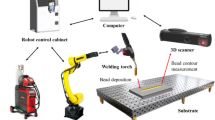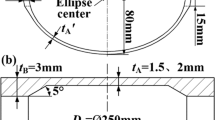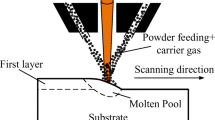Abstract
The thin-walled aerobat shell has the common characteristic structures of staggered internal ribs and curved overhanging gaps, which are prone to the unstable flow of the molten pool during directed energy deposition-arc (DED-Arc), causing a significant decline in the forming accuracy of the components. To avoid this, DED-Arc strategies and process technologies for the characteristic structures were investigated. For the internal circumferential transverse ribs, the deflection deposition process was adopted to transform the molten pool from an overhanging state to a horizontal state to avoid the unstable flow, and a model of the depositional path point set was established based on aerobat shell feature points to ensure the forming accuracy. For internal longitudinal ribs extending in the direction of the inner-wall generatrix, a new hybrid path planning method was proposed, in which the rib contour was deposited first, followed by continuous filling via chamfering scanning or a single pass. This approach avoids the generation of protrusions and depressions when filling longitudinal ribs with irregular cross-section and improves the depositional flatness. For curved overhanging gaps, a novel process method of deflection deposition with a separation path was established. The partial separation path was deposited point by point at the boundary of gaps by adjusting the component deflection angle, which effectively inhibited the molten pool’s unstable flow and avoided deposition collapse. Ultimately, an aluminum-alloy aerobat shell was manufactured through DED-Arc using the established process technologies. The average overall size deviation was about ± 0.8 mm, and the average horizontal and vertical ultimate tensile strengths were 323.9 and 309.3 MPa, respectively, which met the component delivery requirements.



















Similar content being viewed by others
Data availability
The data can be provided by the corresponding author under reasonable requirements.
References
Zhang L, Lv M, Meng J, Du H (2018) Conceptual design and analysis of hybrid airships with renewable energy. J Aerospace Eng 232(1):2144–2159
Bałon P, Rejman E, Smusz R, Szostak J, Kiełbasa B (2018) High speed milling in thin-walled aircraft structures. Appl Comput Sci 14(2):82–95
Slamani M, Chatelain JA II, Balazinski M (2021) Statistical analysis and modeling of temperature distribution during various milling operations of thin walled aircraft parts. Physica A 570:125842
Guo M, Jiang X, Ye Y, Ding Z, Zhang Z (2019) Investigation of redistribution mechanism of residual stress during multi-process milling of thin-walled parts. Int J Adv Manuf Tech 103:1459–1466
He T, Yu S, Shi Y, Huang A (2020) Forming and mechanical properties of wire arc additive manufacture for marine propeller bracket. J Manuf Process 52:96–105
He T, Yu S, Huang A, Yu G (2021) Path planning and forming of wire multi-arc additive collaborative manufacture for marine propeller bracket. J Manuf Process 68:1191–1201
Omiyale BO, Olugbade TO, Abioye TE, Farayibi PK (2022) Wire arc additive manufacturing of aluminium alloys for aerospace and automotive applications: a review. Mater Sci Tech-lond 38(7):391–408
Tasdemir A, Nohut S (2021) An overview of wire arc additive manufacturing (WAAM) in shipbuilding industry. Ships Offshore Struc 16(7):797–814
Li R, Zhang H, Dai F, Huang C, Wang G (2019) End lateral extension path strategy for intersection in wire and arc additive manufactured 2319 aluminum alloy. Rapid Prototyp J 26:360–369
Mehnen J, Ding J, Lockett H, Kazanas P (2014) Design study for wire and arc additive manufacture. Int J Prod Dev 19:2
Rauch M, Hascoet J, Querard V (20021) A multiaxis tool path generation approach for thin wall structures made with WAAM. J Manuf Mater Process 5:128
Yuan L, Pan Z, Ding D, Yu Z, Duin S, Li H, Li W, Norrish J (2021) Fabrication of metallic parts with overhanging structures using the robotic wire arc additive manufacturing. J Manuf Process 63:24–34
Singh P, Dutta D (2003) Multi-direction layered deposition-an overview of process planning methodologies. In: Proceedings of the Solid Freedom Fabrication Symposium 279–288
Kazanas P, Deherkar P, Almeida P, Lockett H, Williams S (2012) Fabrication of geometrical features using wire and arc additive manufacture. In: Proceedings of the institution of mechanical engineers, Part B: J Eng Manuf 226(6):1042–1051
Li Y, Qin X, Wu Q, Hu Z, Shao T (2020) Fabrication of curved overhanging thin-walled structure with robotic wire and arc additive manufacturing (RWAAM). Ind Robot 47(1):102–110
Dai F, Zhang S, Li R, Zhang H (2022) Multiaxis wire and arc additive manufacturing for overhangs based on conical substrates. Rapid Prototyping J 47(1):102–110
Jafari D, Vaneker THJ, Gibson I (2021) Wire and arc additive manufacturing: opportunities and challenges to control the quality and accuracy of manufactured parts. Mater Design 202:109471
Coupek D, Friedrich J, Battran D, Riedel O (2018) Reduction of support structures and building time by optimized path planning algorithms in multi-axis additive manufacturing. Procedia CIRP 67:221–226
Lin Z, Liu P, Yu X (2021) A literature review on the wire and arc additive manufacturing—welding systems and software. Sci Adv Mater 13(8):1391–1400
Wu Z, Narra SP, Rollett A (2020) Exploring the fabrication limits of thin-wall structures in a laser powder bed fusion process. Int J Adv Manuf Tech 110:191–207
Zhang J, Xing Y, Cao J, Zhang X, Yang F (2022) The gap-filling overlapping model for wire and arc additive manufacturing of multi-bead components. Int J Adv Manuf Tech 123:737–748
Xu T, Cui Y, Ma S, Wang J, Liu C (2021) Exploring the inclined angle limit of fabricating unsupported rods structures by pulse hot-wire arc additive manufacturing. J Mater Process Tech 295:117160
Yang M, Liu H, Qi B (2019) The surface depression and temperatures in molten pool with pulsed arc welding. J Manuf Process 37:130–138
Acknowledgements
The authors thank Mr. Guozhi Yu from the School of Materials Science and Engineering of HUST for his help with experiments.
Funding
This work was supported by the Stable Support Project of the National Key Laboratory of High Energy Beam Processing Technology (CN).
Author information
Authors and Affiliations
Contributions
All the authors have contributed to the development of the research and in the elaboration of this paper. Runzhen Yu: investigation, forming analysis, data curation, and writing and editing the original draft. Shengfu Yu: writing—review and editing, supervision, and funding acquisition. Zhenyu Yu and Bo Zheng: resources and data curation.
Corresponding author
Ethics declarations
Ethics approval
There are no ethical issues in this paper.
Consent to participate
Written informed consent for publication was obtained from all participants.
Consent for publication
No conflict of interest exists in the submission of this manuscript, and the manuscript is approved by all authors for publication.
Competing interests
The authors declare no competing interests.
Additional information
Publisher's note
Springer Nature remains neutral with regard to jurisdictional claims in published maps and institutional affiliations.
Rights and permissions
Springer Nature or its licensor (e.g. a society or other partner) holds exclusive rights to this article under a publishing agreement with the author(s) or other rightsholder(s); author self-archiving of the accepted manuscript version of this article is solely governed by the terms of such publishing agreement and applicable law.
About this article
Cite this article
Yu, R., Yu, S., Yu, Z. et al. Directed energy deposition-arc of thin-walled aerobat shell with structures of internal ribs and overhanging gaps. Int J Adv Manuf Technol 127, 305–321 (2023). https://doi.org/10.1007/s00170-023-11450-w
Received:
Accepted:
Published:
Issue Date:
DOI: https://doi.org/10.1007/s00170-023-11450-w




